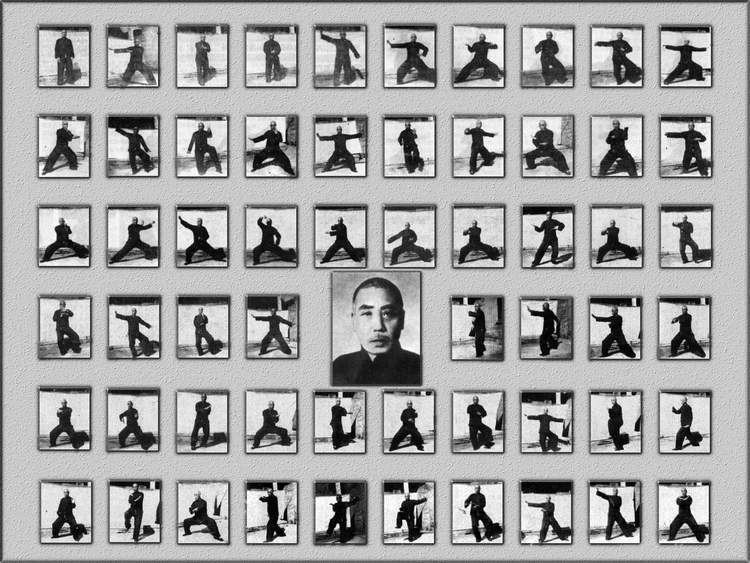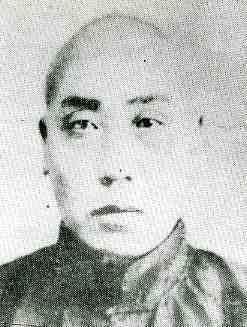Teacher(s) Chen Yanxi (陈延熙) | Name Chen Fake | |
 | ||
Notable relatives Similar Chen Changxing, Wong Fei hung, Guo Yunshen | ||
Tian xuchen 1of2
Chen Fake or Ch'en Fa-k'e (陳發科; 1887–1957) was a Chinese martial artist who taught Chen-style t'ai chi ch'uan. He was born and raised in Chen Family Village (Chenjiagou, 陳家溝) in Henan province. In 1928, Chen Fake moved to Beijing to teach his family’s inheritance; Chen-style t'ai chi ch'uan. After defeating all challengers, Chen attracted a group of students that included many already well known martial artists. Chen Fake was a martial artist and not a scholar and so he did not leave a written record of his achievements. His life story was recorded and told by his sons or students, notably Hong Junsheng. By the time of his death in 1957, Chen had established a martial arts tradition of Chen-style t'ai chi ch'uan that is practiced worldwide.
Contents
- Tian xuchen 1of2
- Pan yongzhou yilu form student of chen fake
- Early life
- Adulthood
- Students
- What is a form
- Enduring legacy
- Tai chi chuan lineage tree with Chen style focus
- References

Pan yongzhou yilu form student of chen fake
Early life

Chen Fake (陳發科), courtesy name Fusheng (福生), was born in 1887, in the village known as Chen Jia Gou (陳家溝), Wen County (溫县), Henan Province (河南). This area was known for their martial arts expertise since the establishment of the village in 1374.

Chen’s great grandfather was Chen Changxing (1771–1853), who taught Yang Luchan (1799–1871), the founder of Yang-style t'ai chi ch'uan. Chen Fake’s father, Chen Yanxi (陈延熙; 1820 ? – ), was an armed escort by profession. This occupation required him to maintain a reputation in martial arts as he traveled around the country protecting his convoys.
Chen Fake was born when his father was in his sixties and both of his older brothers had died. As a result, he lived a relatively pampered life. When Chen was young, he was often sick and sometimes bedridden. Due to his illness, he did not practice his family’s martial art.
This all changed when his father went to Shandong province to teach martial arts to the family of Yuan Shikai (1859–1916) around 1900 when Chen Fake was fourteen. Since this position required Chen Yanxi to be away for an extended period, Yanxi asked his relatives to look after his family. One evening, Chen Fake heard his relatives criticizing his weakness suggesting that he failed to live up to the expectations of his ancestors. (「延熙这一支,辈辈出高手,可惜到发科这一辈就完了,他都十四岁了,还这么虚弱,不能下工夫,这不眼看完了吗?」 ) This disturbed Chen greatly. He wanted to prove his relatives wrong but feared it was too late. He was very poor in terms of martial arts ability, when he compared himself to others within Chen village. This question hounded him until he realized that if he dedicated himself to the practice of his family’s art he could improve his skills. For the next three years, while others rested or relaxed after their daily chores, Chen would practice the various forms in Chen’s family tai chi chuan. If he had any questions, he would ask every one around him for help. His single minded focus made him one of the best practitioner’s in Chen village. His father was pleased with Fake’s achievements when he returned for a visit.
Adulthood
For two generations, the Yang family of Yang Lu-ch'an and the Wu family of Wu Quanyou spread the fame of the martial art of t'ai chi ch'uan throughout the Qing Empire. The Qing government ended by a revolution and similar disruption were happening throughout Chinese society. It was during these turbulent times that Chen Zhaopei (陈照丕; 1893–1972) went to Beijing to teach Chen's style Tai Chi Chuan in 1928. Chen Zhaopei’s instructions attracted considerable interest and in 1930 he was invited to teach in Nanjing. Zhaopei did not want to leave his Beijing students so he suggested that they invite his uncle Chen Fake to take his place. At this time Chen Fake moved from a small village in Henan Province to the thriving metropolis of Beijing.
Before the arrival of Chen Fake, the public perception of t'ai chi ch'uan was based on the views of the Yang style and Wu style. This meant that the t'ai chi ch'uan forms were practiced as slow and relaxed movements. Chen Fake showed a different type of training that at times can include fast vigorous actions and explosive moves. So in the beginning, many within the Beijing martial arts community doubt the authenticity of Chen Fake’s quan. According to Chinese tradition, when Chen first arrived in the Chinese capital, he was openly challenged by other martial artists in order to establish his credibility. In those impromptu competitions, there were no rules and no preparations so they could be quite dangerous. For the next thirty years, Chen remained undefeated. Chen not only established an unparalleled martial arts reputation but earned the public’s respect for his morality and integrity.
According to his student, Hong Junsheng, Chen Fake never criticizes other martial artists either publicly or privately. Chen would also admonish his students for criticizing others. Master Chen was quoted as saying: “The pillar of socialization is loyalty and the method of dealing with people should be based on modesty and cooperation. Loyalty fosters trust; modesty encourages progress; and cooperation befriends people. Modesty and cooperation should be based on loyalty not on hypocrisy.”
Students
There were many stories about the abilities of Chen Fake but what is unquestioned is his establishment of a Chen t'ai chi ch'uan tradition outside of Chen Village. During his teaching career in Beijing, he trained hundreds of students, some of which were already well known martial artists. By the time of Chen’s death in 1957, his students became respected as Chen Stylists in their own right and later trained the next generation of Chen Tai Chi Chuan practitioners.
Some of the more prominent and recognized students of Chen Fake are his two sons and daughter as many well known martial artists. His sons and daughter were:
His nephew was:
Some of his students were:
What is a form?
Conventional history credits Chen Fake with the creation of the New Frame (Xin Jia, 新架) of Chen t'ai chi ch'uan that are currently practiced by some branches of Chen t'ai chi ch'uan practitioners. He is also given the credit of promoting the Old Frame (老架) which is the form he taught when he first arrived in Beijing. Each instructor after Chen Fake also performs and teaches the form slightly differently. This proliferation of styles has led to the obvious argument about the authenticity of the forms. As an extension of this question, the t'ai chi ch'uan community also tried to debate the merits of the different t'ai chi ch'uan Styles or even the difference between Internal and External martial arts. This quest for authenticity and efficacy is one attempt to prove the legitimacy of the training within the traditional Chinese martial arts.
For Chen style t'ai chi ch'uan, Chen Fake did not leave any written material to indicate his view on the matter of form. Hong Jung Shen noted that Chen Fake changed his teaching method over his thirty years career. Hong also noticed that his fellow students such as Chen Zhaoxu, Chen Zhaokui and Feng Zhiqiang all practiced their forms differently from him. Hong finally asked Chen Fake about this issue during his last meeting with his teacher in 1957. Chen told Hong to ignore the external appearance of the form but focused on the idea that any correct t'ai chi ch'uan form should be based on the same fundamental principle and that each element of a form should have a purpose. Accordingly, the external appearance is not important as long as those two requirements are met. In Chen Fake’s words: “This set of Taijiquan does not have one technique which is useless. Everything was carefully designed for a purpose.” (“这套拳没有一个 动作是空的, 都是有用的”) . This principle, according to Hong, can be derived from “The Taijiquan Treatise” (太极拳论) by Wang Zongyue (王宗岳). This idea is expressed by the phrase “Although there are myriad variations, there is only one underlying principles.” (“虽变化万端, 而理为一贯”).
Enduring legacy
Chen Fake and his generation were probably the last true traditional Chinese martial artists. It is only through a series of fortunate coincidences that he was able to teach his art in the capital of the Chinese nation. He attracted and cultivated a group of exceptional students and those students ensured that his knowledge and skills were passed down. Even through the turmoil of the Cultural Revolution and the eventual international dissemination, this selected group and now their students continues to teach according to their master’s instructions. This dedication provided the strong foundation needed to foster a thriving and sustainable Chen style t'ai chi ch'uan community. Chen t'ai chi ch'uan practitioners can now be found all over that world. This is the enduring legacy of Chen Fake.
T'ai chi ch'uan lineage tree with Chen-style focus
The lineage tree is a simplified representation of the student-master relationships for t'ai chi ch'uan. The real story is considerable more complex because some students studied under many teachers. What is the most important point from the lineage tree is the pivotal role of Chen Fake and his contribution to the dissemination of Chen t'ai chi ch'uan outside of Chen village. A minor error in the tree is the linkage between Chen Zhaopi (陈照丕). Chen Zhaopi did not train with the father of Chen Fake (Chen Yanxi, 陈延熙) but rather Zhaopi’s own father Chen Dengke (陈登科). Chen Dengke was of the same generation as Chen Fake. Chen Dengke’s father is Chen Yannian (陈延年) who was the brother of Chen Fake’s father, Chen Yanxi (陈延熙). The father of both Yannian and Yanxi was Chen Gengyun (陈耕耘). As the tree shows, Gengyun was of the same generation as the other t'ai chi ch'uan luminaries such as Yang Luchan and Chen Qingping (陈清萍). Both Luchan and Gengyun were students of Chen Changxing (陈长兴).
